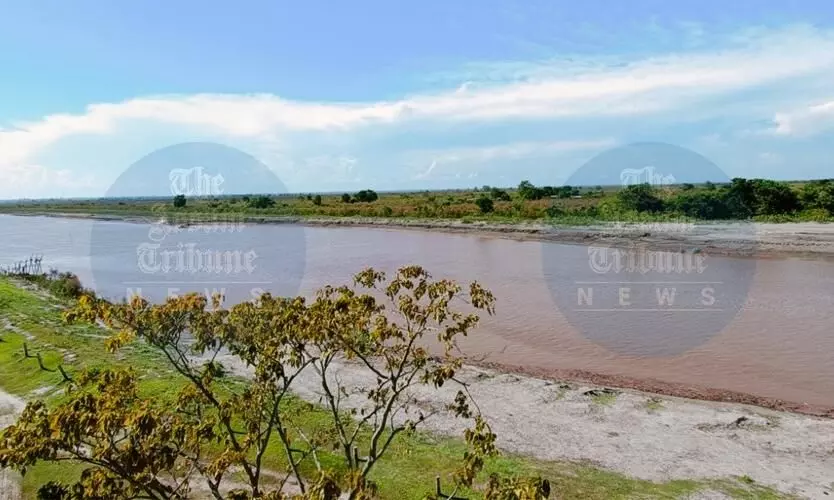
AT Photo
Sivasagar, Oct. 7: Jhanjimukh, 30 km from Teok Mudoijan on National Highway-37 (NH 37), consists of several remote and sparsely populated villages, including Jhanjimukh Kumar Gaon, Bhokot Gaon, and Japung Gaon. Here, the river Janjhi meets the mighty Brahmaputra.
This place is set to become an important ecotourism centre in Assam. The greenery on one side beyond the dykes and the tall reed-filled dunes on the south bank of the Brahmaputra, the streams of Jhanji and Metong, the villagers, and the scenic beauty of the confluence of the river Jhanji with the Brahmaputra can be inviting for nature lovers.
The massive 8-km-long Majuli-Jorhat bridge over the Brahmaputra begins here on the southern bank of the river. When The Assam Tribune reached the place a couple of days ago, the construction work on the bridge had stopped due to problems involving the construction firm. The BRC (Badri Rai Construction Limited) Group, which was constructing the base of the giant pillars, suspended its work a fortnight ago. However, it is hoped that the work will resume soon as the UP State Bridge Corporation Limited has been now assigned the task of completing the mega project by November 2025.
Adding to the importance of the area, the 1,630-km- long Numaligarh-Paradip crude oil pipeline project is also running in parallel to the bridge construction work at Jhanjimukh. The pipeline project is being implemented by Kirloskar Ebara Pumps Limited.
Several individuals and organisations in Majuli, including Dr Pitambar Deva Goswami, Satradhikar of Sri Sri Auniati Satra, have voiced concern over halting of the construction work and have sought the Chief Minister's intervention in the matter. Several massive pillars on either bank of the river have already been constructed. Barring a few security personnel, there were no company officials present when this correspondent arrived at the gate of the BRC group's camp on the southern bank of the Brahmaputra.
When the bridge is completed, the people of the Jhanjimukh area are expected to witness a flurry of activities from entrepreneurs to open new business ventures as a heavy rush of tourists to the area is very much on the cards.
Borolia fish, an indigenous small fish known for its superior taste, is found in abundant quantity at the confluence of the rivers Jhanji and Brahmaputra. Though the local fishermen have to sell the daily collection to the middlemen who send the fish to markets in Jorhat and Sivasagar, they oblige the occasional tourists, too, on request. During high floods, however, the whole area gets inundated. The water recedes within days, leaving the low-laying fields enriched with alluvial silt and making it more fertile to grow winter crops.
Be that as it may, a comprehensive development plan needs to be chalked out by the government, political representatives, local panchayats, and departments like tourism and PWD to transform Jhanjimukh into a truly modern eco-tourism destination without destroying its pristine beauty.
It is pertinent to mention in this context that the paver-block road from Mudoijan is very narrow and without side bund, which makes it perilous for motorists during rainy days.
By
Manoj Borthakur

